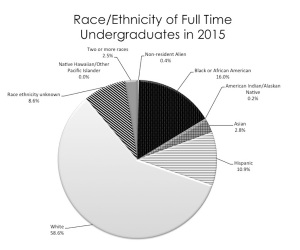Jessica Pellegrino – General Assignment Reporter
According to the Southern Connecticut State University Fact Book, a census published through The Office of Institutional Research, only 58 percent of SCSU’s full-time undergraduate students are Caucasian, and the number is dropping.
In 2010, the Fact Book reported that 69.3 percent of full-time Southern undergraduate students were Caucasian. In 2011, the number dropped three percent. The number continues to drop at a rate of roughly three percent per year. This pattern is similar in part-time undergraduates as well, only at an even faster rate.
Conversely, other ethnicities show no substantial growth or decline. According to Berthania Boursiquot, a senior psychology major, Southern does a successful job of representing the minorities on campus.
“I define myself as black, even though my parents are from Haiti,” said Boursiquot. “So, yeah, I am a minority. But, I really do think that Southern represents me well because I feel as though Southern is very diverse and I am very proud of it.”

Southern has representation from African Americans, Asians, American Indians and Native Hawaiians/Pacific Islanders, to name a few.
Boursiquot said, “I feel like there are always events or programs being held for minorities on campus, so the university really does go a long way to make sure minorities feel represented.”
Boursiquot believes that Southern does an excellent job of ensuring that its students are being represented. “I do not think much really needs to change for the university in order to represent minorities,” she said. “The host events for Latin American and African American students constantly.”
Queen DeLeon, a Spanish major and Asian student, agrees that Southern represents minorities well.
“Considering that 42 percent of students are non-Caucasian, then I guess I am in the minority, but it does not really seem like a huge gap,” she said. “It seems like a pretty fair balance of representation. I think that the university is alright with representing all ethnicities. I personally have not seen an issue so far.”
According to President Mary Papazian’s blog, the President attended a conference through the American Association of Colleges and Universities in Austin, Texas. At the conference, the changing dynamics of public institutions were discussed. “The focus this year was on the changing demographics of the U.S. population. The federal Census Bureau predicts that by 2042, ‘racial minority’ groups will make up the majority of the U.S. population, a trend that has profound implications for colleges and universities,” said Papazian in a blog entry.
Not all students believe the university fairly represents them, however. Stephanie Chang, an Asian-Hispanic student, believes that there is always something more that can be done when it comes to representation.
“I do define myself as a minority,” said Chang. “I come from a family that is of Asian and Hispanic descent.”
She said universities as an institution are inherently inclusive, but in reality, are still white systems.
“For me I think most universities feel as if they are being inclusive, or that they well represent minorities, but the truth of the matter is most of them fail because of their lack of knowledge on what it means to be a minority in a predominantly white university system,” said Chang.

This is not something that begins and ends at admissions. Chang believes that this unintentional exclusive runs deep.
“That includes different layers of issues, from academia, to income, to inclusion in sports and activities, and to overall social inclusion in a university environment,” said Chang. “I think once the university touches upon these different layers of issues within its university system, in regards to minorities, then I will feel that the universities will well represent minorities in all aspects.”
But, Chang believes that universities can always improve and that the battle for representation is not over.
“The university should be open to listening more about the issues of minorities face no matter how small they may seem,” said Chang.
Photo Credit:


























































































